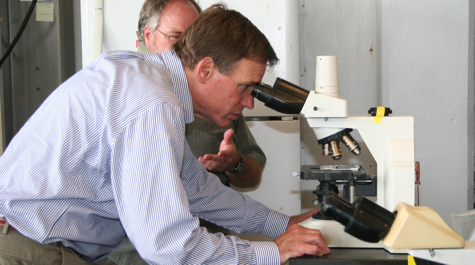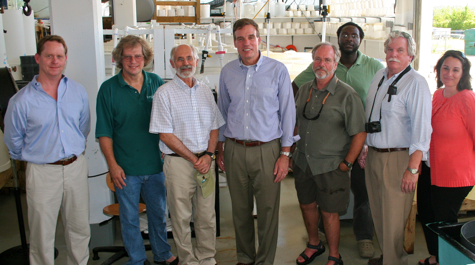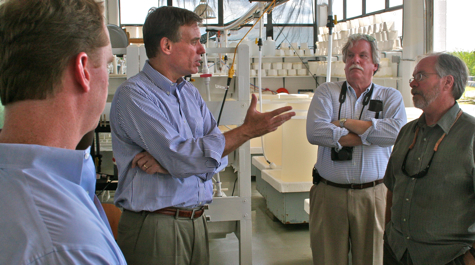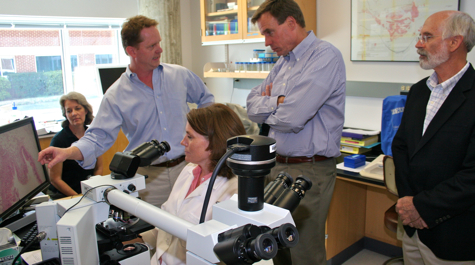Senator Warner visits VIMS to discuss oyster restoration
Virginia Senator Mark Warner visited the Virginia Institute of Marine Science on July 9th to discuss oyster-restoration strategies in Chesapeake Bay. The stop was his last on a three-day trip through Hampton Roads and the Eastern Shore.
Warner's visit coincides with a growing recognition among scientists, policymakers, and industry that increased disease resistance, a local surge in oyster aquaculture, and recently announced federal restoration goals promise new opportunities in ongoing efforts to restore oysters to the Bay.
"Scientists at VIMS are applying their expertise to lead some great research into our efforts to restore oysters and other shellfish in Chesapeake Bay," Senator Warner said. "I also was pleased to learn that VIMS is involved in the response and recovery efforts from the Gulf of Mexico oil spill, because the slow-motion Gulf disaster will have an impact on Virginia's watermen, our seafood processors, and this region's aquaculture industries."
During his visit to VIMS, Senator Warner visited the VIMS Oyster Hatchery, where he engaged Drs. Stan Allen and Roger Mann in a broad discussion of VIMS' cutting-edge role in breeding disease-resistant oysters for aquaculture. Their conversation included discussion of how the Gulf oil spill is affecting the nationwide oyster market, and of the steps that Virginia can take to help restore its oyster industry to its former prominence.
Allen, who heads the Aquaculture Genetics and Breeding Technology Center at VIMS, described his group's efforts to domesticate oysters through selective breeding and genetic research.
Allen said that his group's overall goal is to "provide genetically superior brood stock to industry for use in aquaculture," and noted that their success in developing disease-tolerant strains has now allowed them to focus on improving other production traits, such as growth and meat yield. The lab has distributed a growing number of oyster broodstock to commercial hatcheries in the past five years, from 100 in 2004-2005 to 7,000 in 2008-2009.
Mann, Director of Research and Advisory Service at VIMS, put the oyster restoration efforts in their broader, historical context, describing the growing recognition that restoration includes both ecological and economic goals, and that the focus of these goals may differ.
Native Populations Developing Resistance
Senator Warner also met with Dr. Ryan Carnegie, a Research Assistant Professor in the Institute's Shellfish Pathology Laboratory. Carnegie leads the lab's unique, 50-year study of MSX and Dermo, diseases that have helped push populations of Chesapeake Bay oysters to one percent of historical levels.
A report issued by the lab in late 2009 shows that the Bay's oysters are developing resistance to both MSX and Dermo, despite the increasing prevalence in the Bay of the parasites that cause these diseases. MSX disease results from an infection by the single-celled protozoan Haplosporidium nelsoni. Dermo is caused by the parasite Perkinsus marinus.
The oyster's increased disease tolerance strengthens the case for including harvest-free oyster reefs in restoration strategies. These sanctuaries would maximize the opportunity for reproductively capable, resistant oysters to produce disease-resistant offspring for Bay waters. Sanctuary efforts have long been controversial because of the perception that many oysters that could otherwise be harvested die of disease before they reproduce.
Oyster Aquaculture on the Upswing
The most recent study of oyster aquaculture in the Commonwealth, by researchers with the Sea Grant Extension Program at VIMS, shows that Virginia's oyster hatcheries sold 18-times more seed and larvae in 2008 than in 2007, and that they predicted an additional 4-fold increase in sales in 2009.
The study also showed that 9.8 million farmed oysters went to market in 2008—up from 4.8 million in 2007, and surpassing the industry prediction of 7.3 million. The sale of farmed oysters by Virginia growers has increased 10-fold since the initial VIMS survey in 2004. In previous years, hatchery production of seed seemed to be a limiting factor in the growth of oyster aquaculture in the Commonwealth, but the data suggest that hatcheries are ramping up production to meet the demand for seed and larvae.
VIMS Dean and Director John Wells says "VIMS has some of the world's leading oyster researchers, and we look forward to continuing our leadership role in oyster restoration, as well as in advancing new opportunities for oyster aquaculture."




